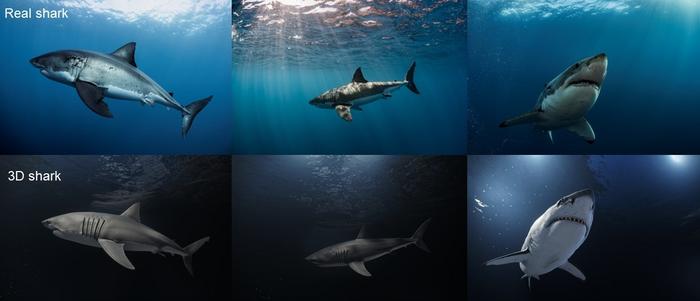AMHERST, Mass. – Ground-breaking 3D interactive shark imagery created by a University of Massachusetts Amherst biology professor is powering a new World of Sharks website launched by the Save Our Seas Foundation to inform the public on the critical role sharks play in the world’s oceans.

Credit: Johnson Martin
AMHERST, Mass. – Ground-breaking 3D interactive shark imagery created by a University of Massachusetts Amherst biology professor is powering a new World of Sharks website launched by the Save Our Seas Foundation to inform the public on the critical role sharks play in the world’s oceans.
The Save Our Seas Foundation (SOSF), in collaboration with Duncan Irschick, professor of biology at the University of Massachusetts Amherst and director of the Digital Life Project, is bringing sharks to life and into your living room thanks to interactive, first-of-their-kind 3D models that are downloadable and free-to-use for non-profit applications.
Have you ever wondered how many kinds of sharks there are? Which is the biggest shark, or the fastest? For answers to these and many more questions, the SOSF has built the World of Sharks website as a one-stop-shark-information shop—including the world’s most realistic models.
“Our great white shark 3D model is the most accurate one out there,” says Irschick. “When Hollywood makes sharks, they build them for entertainment, making them look bigger and more vicious. But we’ve built these models based on the science of shark biology and morphology. Realism matters, and it’s important to get it right.”
“We wanted World of Sharks to be the ultimate shark FAQ, which could answer many questions about sharks and rays,” says SOSF CEO James Lea. “Through engaging and accessible content, we hope to grow a repository of fascinating shark facts that people can trust.” The World of Sharks website hosts interactive models of the white shark and manta ray, and additional models can be found online at SOSF’s Shark Education Centre.
Irschick, who works closely with his UMass Amherst students on his models, stresses that “it’s vital for undergraduates and graduate students to learn how to work with non-academic partners.” For his collaboration with the SOSF, Irschick and his team, including UMass undergraduates Emma Hsiao and Braedon Fedderson and graduate student Josh Medina, drew deeply on scientific data gleaned from years of research, media provided by the SOSF, and computer graphics created by artist Johnson Martin to reconstruct the species so that they look and move realistically.
“I was really wanting to create something 3D and interactive, where visitors to the World of Sharks can explore in an engaging way that highlights the unique physiology and evolution of sharks and rays and demystifies their unique adaptations,” explains Jade Schultz, content manager for the SOSF.
The interactive models allow website users to understand different elements of shark and ray physiology: for instance, hovering your cursor over key features will bring up information on everything from how manta rays filter feed and why they are under threat, to facts about how shark dorsal fins are used by scientists to identify individuals in a population.
While concerted efforts by researchers and educators are turning the tide for sharks and rays, there remain significant challenges. With over one third of these species threatened with extinction, there is still much work to be done to change misconceptions, banish misinformation and empower people with useful information so that they can also participate in conservation. “The key to all of our understanding of sharks—why they do what they do and what is needed to help them recover—relies on there being a foundation of basic, reliable life-history information,” says Lea.
A new website for the SOSF-Shark Education Centre (SEC) will host a larger portfolio of 3D sharks found in False Bay, the largest bay in southern Africa. Young, in-person visitors to the SEC, in Cape Town, South Africa, who would never otherwise dip below the waves to see these creatures, will now be able to see an endemic catshark curl into a defensive donut-shape. From iPads in the Centre, or at home online, learners can marvel at the most amazing feats of the sharks that live in False Bay. Simulating the behavior of white sharks and understanding how sharks move in their environment gives children an immersive experience, regardless of their access to the ocean.
Clova Mabin, director of the SOSF-SEC, enthuses, “We also think that it might be possible to use them as a teaching tool in the classroom, to simulate fieldwork. Learners could view them on the iPads and potentially take various measurements, comparing across the different species.”
Contacts:
Aurélie Grospiron (Save Our Seas Foundation), [email protected]
Duncan Irschick (UMass Amherst), [email protected]
Daegan Miller, [email protected]




